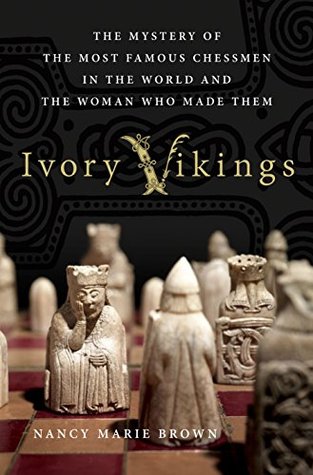More on this book
Kindle Notes & Highlights
Read between
June 30 - August 22, 2020
More medieval literature exists in Icelandic than in any other European language except Latin.
The word translated as “chess” is tafl, a cognate to our word table,
Snorri compiled most of what we know about Norse mythology.
The Saga of Bishop Pall appeared, providentially, in 2002; reading it, Thorarinsson was intrigued by the story of Margret the Adroit and her patron, Bishop
the word rook, from Arabic rukh, means “chariot,”
Berserks—meaning “bear-shirts” or “bare-shirts”—were the god Odin’s warriors. Foot soldiers in the forefront of battle, they “wore no armor and were as mad as dogs or wolves, bit their shields, were as strong as bears or bulls. They killed other men, but neither fire nor iron could kill them. That is called going berserk,” explained the thirteenth-century Icelandic writer Snorri Sturluson. Sometimes the “bear-shirts” wore shirts of wolf skin instead.
Black and tough, one hide weighs from one to five hundred pounds. Split, cured, and twisted into rope, walrus hide made the best ships’ rigging; one bull supplied enough cordage for two to three large trading knarrs.
Permian rings, these thick silver neck rings with spiral grooves and hook-and-loop closures have been found from Perm, near the Ural Mountains, west to Ireland and England.
Chess seems to have arrived in Persia from India in the mid-500s.
chess set made of elephant ivory, kept in the treasury of the Abbey of Saint Denis in the thirteenth century and now in the National Library in Paris,
datable proof of European chess comes from 997.
The most famous Viking swords were of Frankish make and inlaid with the trade name “Ulfberht”
Viking Ship Museum in Roskilde, Denmark,
Norway itself gets its name from a trade route: the “North Way”
The Lewis chessmen, being the oldest extant sets that unmistakably include bishops, could mark the debut of the bishop on the board.
first use of the chess term bishop, which has remained the name of the piece in English.
Thomas Becket, martyred at the altar of Canterbury Cathedral in 1170;
the last pagan amulets in the shape of Thor’s hammer date from the early 1100s.
Christ in the Viking Age was always shown triumphant: not as the suffering and dying savior, but as the victorious harrower of Hell.
Uig itself comes from the Norse word for bay, vík, possibly the root of “Viking.”
Rome did not require priests and bishops to be celibate until after the First Lateran Council in 1123, and the rule took nearly a hundred years to take root in Iceland.
around 1190, chess was well known throughout Europe; most likely it was known in Iceland too, though the first datable reference to it is in Snorri Sturluson’s
Svein Asleifarson, sometimes called “the last Viking”:
When the Lewis chessmen were carved, the queen moved one space per turn, and only on the diagonal,
The first hint of the queen as an “awesome warrior” comes in a thirteenth-century French poem comparing the Virgin Mary to a chess queen:
Not until 1497, when Isabella of Castile ruled Spain and its New World colonies, does a chess treatise recognize the queen as the strongest piece on the board. After that come many references to “queen’s chess” or “mad chess”—our modern game.
Queen Gunnhild the Grim, also known as Gunnhild Kings-Mother, the wife of King Eirik Blood-Axe.
in 1179, Sverrir’s opponents flipped the board. Except for the single king piece, the defenders and attackers in hnefatafl are all the same. Chess introduces pieces of different weights.
The important pieces in this new game were the bishops: As in chess, the church had the power to win the war.


